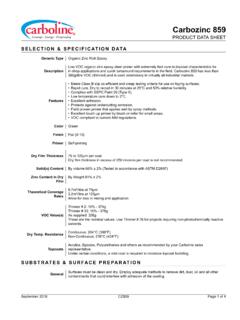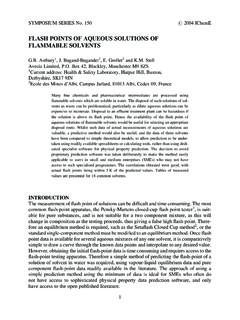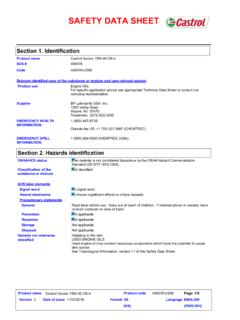Transcription of Standard Test Method for Flash and Fire Points by ...
1 Designation: D 92 05aDesignation: 36/84 (89)An American National StandardAmerican Association StateHighway and Transportation Officials StandardAASHTO No.: T48 DIN 51 376 Standard Test Method forFlash and Fire Points by Cleveland Open Cup Tester1 This Standard is issued under the fixed designation D 92; the number immediately following the designation indicates the year of originaladoption or, in the case of revision, the year of last revision. A number in parentheses indicates the year of last reapproval. A superscriptepsilon ( ) indicates an editorial change since the last revision or Standard has been approved for use by agencies of the Department of Flash point and fire point test Method is a dynamic Method and depends on definite rates oftemperature increases to control the precision of the test Method . Its primary use is for viscousmaterials having Flash point of 79 C (175 F) and above.
2 It is also used to determine fire point, whichis a temperature above the Flash point, at which the test specimen will support combustion for aminimum of 5 s. Do not confuse this test Method with Test MethodD 4206,which is a sustainedburning test, open cup type, at a specific temperature of 49 C (120 F). Flash point values are a function of the apparatus design, the condition of the apparatus used, andthe operational procedure carried out. Flash point can therefore only be defined in terms of a standardtest Method , and no general valid correlation can be guaranteed between results obtained by differenttest methods, or with test apparatus different from that Scope* This test Method describes the determination of the flashpoint and fire point of petroleum products by a manualCleveland open cup apparatus or an automated Cleveland opencup The precisions for fire point were not determined in thecurrent interlaboratory program.
3 Fire point is a parameter that is notcommonly specified, although in some cases, knowledge of this flamma-bility temperature may be This test Method is applicable to all petroleum productswith Flash Points above 79 C (175 F) and below 400 C(752 F) except fuel This test Method may occasionally be specified for thedetermination of the fire point of a fuel oil. For the determination of theflash Points of fuel oils, use Test MethodD93. Test MethodD93shouldalso be used when it is desired to determine the possible presence of small,but significant, concentrations of lower Flash point substances that mayescape detection by Test Method D 92. Test MethodD 1310can beemployed if the Flash point is known to be below 79 C (175 F). The values stated in SI units are to be regarded as thestandard. The values given in parentheses are for Standard does not purport to address all of thesafety concerns, if any, associated with its use.
4 It is theresponsibility of the user of this Standard to establish appro-priate safety and health practices and determine the applica-bility of regulatory limitations prior to specificwarning statements, , , , Referenced Standards:2D93 Test Methods for Flash Point by pensky -MartensClosed Cup TesterD 140 Practice for Sampling Bituminous MaterialsD 1310 Test Method for Flash Point and Fire Points ofLiquids by Tag Open-Cup ApparatusD 4057 Practice for Manual Sampling of Petroleum andPetroleum ProductsD 4177 Practice for Automatic Sampling of Petroleum andPetroleum Products1 This test Method is under the joint jurisdiction of ASTM Committee D02 onPetroleum Products and Lubricants and is the direct responsibility of on Volatility. In the IP, this test Method is under the jurisdiction of theStandardization Committee. This test Method was adopted as a joint ASTM-IPstandard in edition approved July 1, 2005.
5 Published August 2005. Originallyapproved in 1921. Last previous edition approved in 2005 as D 92 referenced ASTM standards, visit the ASTM website, , orcontact ASTM Customer Service at ForAnnual Book of ASTMS tandardsvolume information, refer to the Standard s Document Summary page onthe ASTM *A Summary of Changes section appears at the end of this ASTM International, 100 Barr Harbor Drive, PO Box C700, West Conshohocken, PA 19428-2959, United by ASTM Int'l (all rights reserved); Fri Apr 17 06:45:30 EDT 2009 Downloaded/printed byLaurentian University pursuant to License Agreement. No further reproductions 4206 Test Method for Sustained Burning of Liquid Mix-tures Using the Small Scale Open-Cup ApparatusE1 Specification for ASTM Liquid-in-Glass ThermometersE 300 Practice for Sampling Industrial Institute Standard :4 Specifications for IP Standard Standards:5 Guide 34 Quality Systems Guidelines for the Production ofReference MaterialsGuide 35 Certification of Reference Material General andStatistical Principles3.
6 ,adj in petroleum products, the conditionwhere the vapor above the test specimen and the test specimenare not in temperature equilibrium at the time that the ignitionsource is This is primarily caused by the heatingof the test specimen at the constant prescribed rate with thevapor temperature lagging behind the test specimen point,n in petroleum products, the lowest tem-perature corrected to a barometric pressure of kPa (760mm Hg), at which application of an ignition source causes thevapors of a test specimen of the sample to ignite and sustainburning for a minimum of 5 s under specified conditions point,n in petroleum products, the lowesttemperature corrected to a barometric pressure of kPa(760 mm Hg), at which application of an ignition source causesthe vapors of a specimen of the sample to ignite under specifiedconditions of The test specimen is deemed to haveflashed when a flame appears and instantaneously propagatesitself over the entire surface of the test When the ignition source is a testflame, the application of the test flame can cause a blue halo oran enlarged flame prior to the actual Flash point.
7 This is not aflash point and shall be Summary of Test Approximately 70 mL of test specimen is filled into atest cup. The temperature of the test specimen is increasedrapidly at first and then at a slower constant rate as the flashpoint is approached. At specified intervals a test flame is passedacross the cup. The Flash point is the lowest liquid temperatureat which application of the test flame causes the vapors of thetest specimen of the sample to ignite. To determine the firepoint, the test is continued until the application of the test flamecauses the test specimen to ignite and sustain burning for aminimum of 5 Significance and The Flash point is one measure of the tendency of the testspecimen to form a flammable mixture with air under con-trolled laboratory conditions. It is only one of a number ofproperties that should be considered in assessing the overallflammability hazard of a Flash point is used in shipping and safety regulations todefine flammable and combustible materials.
8 Consult theparticular regulation involved for precise definitions of Flash point can indicate the possible presence of highlyvolatile and flammable materials in a relatively nonvolatile ornonflammable material. For example, an abnormally low flashpoint on a test specimen of engine oil can indicate This test Method shall be used to measure and describethe properties of materials, products, or assemblies in responseto heat and a test flame under controlled laboratory conditionsand shall not be used to describe or appraise the fire hazard orfire risk of materials, products, or assemblies under actual fireconditions. However, results of this test Method may be used aselements of a fire risk assessment that takes into account all ofthe factors that are pertinent to an assessment of the fire hazardof a particular end The fire point is one measure of the tendency of the testspecimen to support Open Cup Apparatus (manual) This appa-ratus consists of the test cup, heating plate, test flame applica-tor, heater, and supports described in detail in theAnnex assembled manual apparatus, heating plate, and cup areillustrated inFigs.
9 1-3, respectively. Dimensions are listed withthe Open Cup Apparatus (automated) This ap-paratus is an automated Flash point instrument that shallperform the test in accordance with Section11 Procedure. Theapparatus shall use the test cup with the dimensions asdescribed inAnnex A1and the application of the test flameshall be as described inAnnex Measuring Device A thermometer hav-ing the range as shown below and conforming to the require-ments prescribed in SpecificationE1or in the Specificationsfor IP Standard Thermometers, or an electronic temperaturemeasuring device, such as a resistance thermometer or ther-mocouple. The device shall exhibit the same temperatureresponse as the mercury NumberTemperature RangeASTM IP 6 to +400 C11C 28C20 to 760 from Energy Institute, 61 New Cavendish St., London, W1M 8AR, from American National Standards Institute (ANSI), 25 W.
10 43rd St.,4th Floor, New York, NY 05a2 Copyright by ASTM Int'l (all rights reserved); Fri Apr 17 06:45:30 EDT 2009 Downloaded/printed byLaurentian University pursuant to License Agreement. No further reproductions Flame Natural gas (methane) flame and bottledgas (butane, propane) flame have been found acceptable for useFIG. 1 Cleveland Open Cup 2 Heating PlateFIG. 3 Cleveland Open CupD92 05a3 Copyright by ASTM Int'l (all rights reserved); Fri Apr 17 06:45:30 EDT 2009 Downloaded/printed byLaurentian University pursuant to License Agreement. No further reproductions the ignition source. The gas flame device is described indetail inAnnex A1.(Warning Gas pressure supplied to theapparatus must not be allowed to exceed 3 kPa (12 in.) of waterpressure.)7. Reagents and Solvents Use suitable technical grade solventcapable of cleaning out the test specimen from the test cup anddrying the test cup.



